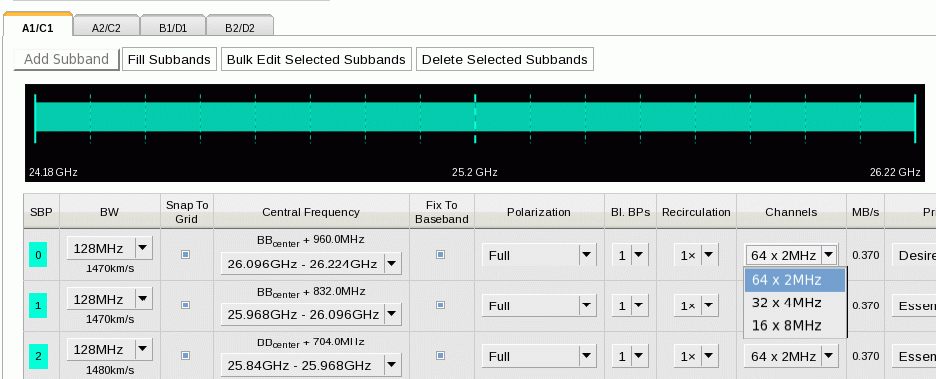Channel Averaging (temporarily disabled)
Since we are unable to support channel averaging (also known as frequency averaging) at this time, it has been temporarily disabled in the RCT.
For continuum observations, the nominal correlator output with 64 full polarization, 2 MHz-wide frequency channels is more than needed to determine the delay and bandpass shape. That is, it does unnecessarily add to the total data rate and data volume and thus to the total transfer and post-processing time. Reducing the number of output channels while retaining the full bandwidth by averaging frequency channels is thus generally beneficial for wideband continuum setups.
The VLA now supports channel averaging (sometimes referred to as frequency averaging) in the correlator. Averaging of factors of two and four for specific cases (see below) is considered commissioned and available under the General Observing capabilities. Averaging of higher factors and/or for other cases may be offered under the Resident Shared Risk Observing program. The ultimate intention is to expand the use and possibly making it the default observing mode for wideband continuum. As there may be noticeable observational effects, a more detailed description to assess the suitability of frequency averaging for an observation can be found in EVLA memo 199 and the section about Chromatic Aberration in the OSS.
Channel averaging in General Observing capability mode is only offered under these conditions:
- Wideband continuum observations using 3-bit setups (frequency bands above 4 GHz, C- through Q-band)
- Frequency averaging factors are two or four (from 2 MHz to 4 MHz or 8 MHz continuum channels)
Note, OTF or Subarray observations are not allowed to use frequency averaging at this time.
The above implies that only 128 MHz full polarization subbands in all four basebands qualify for channel averaging, but this restriction may change in the future. So if the goal of a resource is to observe spectral lines in one or more basebands, where typically one would either reduce the subband bandwidth or increase the number of channels to maximize the spectral resolution, this dissatisfies the condition above.
Averaging frequency channels is implemented using the RCT. Create your own named resource, e.g., by copying one of the default NRAO 3-bit resources to your own catalog and rename it to reflect the change.
To edit all subbands across all basebands, take the following steps in the Subbands tab of your resource (Figure 3.5.1):
- Click on the All button in the All Subbands section,
- Select the Bulk Edit button,
- Select the averaging requested using the bulk edit menu (Figure 3.5.1). Once you have selected the desired channel averaging, click the Apply button.
|
|
|---|
| Figure 3.5.1: Bulk scan edit subbands option for selecting frequency averaging. |
Alternatively, to edit only the subbands within a selected baseband, take the following steps in the Subbands tab of your resource (Figure 3.5.2):
- Select the baseband, e.g., A1/C1,
- Click on the All button in the Subbands in Baseband section,
- Select the Bulk Edit button,
- Select the averaging requested using the bulk edit menu and select the appropriate value in the pull-down menu for channels. Once you have selected the desired channel averaging, click the Apply button.
 |
|---|
| Figure 3.5.2: Select frequency averaging per subband. |





Connect with NRAO